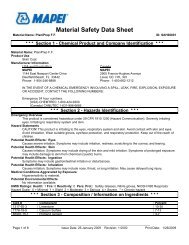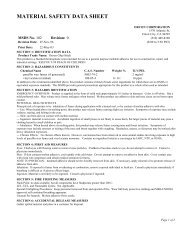R-2000 MSDS - Deco Pour
R-2000 MSDS - Deco Pour
R-2000 MSDS - Deco Pour
You also want an ePaper? Increase the reach of your titles
YUMPU automatically turns print PDFs into web optimized ePapers that Google loves.
Material Safety Data SheetU.S. Department of LaborMay be used to comply with:Occupational Safety & Health AdministrationOSHA’s Hazard Communication Standard(Non-Mandatory Form)29 CFR 1910.1200. Standard must be: Form Approvedconsulted for specific requirements: OMB No. 1218-0072IDENTITY: RAECO R-<strong>2000</strong> BONDING AGENTSection IRaeco, Inc. Revised: 1-10-2004915 S. Carstens PlP.O. Box 80545Seattle, Washington 98108(206) 763-1335Section II - Hazardous Ingredients/Identity InformationHazardous Components OSHA PEL ACGIH TLV Other LimitsEthylene-Vinyl Acetate Co-PolymerResidual MonomersNot HazardousNot HazardousNot a hazardous material as defined in title 29 CFR parts 1900 to 1910Section III - Physical/Chemical CharacteristicsBoiling Point:212FSpecific Gravity (H 2 O=1): .98-1.04Vapor Pressure (mm Hg):17.5 mm Hg @ 20CMelting Point:NAVapor Density (AIR=1):.624 @ 80FEvaporation Rate (Butyl Acetate=1): NASolubility in Water:EmulsionAppearance & Odor:White liquid, MildSection IV - Fire & Explosion Hazard DataFlash Point:NAFlammable Limits:NAExtinguishing Media:NASpecial Fire Fighting Procedures: Water fog dried resin only. Wear positive pressure self-contained breathing apparatus.Unusual Fire & Explosion Hazards: As latex, material’s not combustible; however dried resin is combustible similar to wood. Burningdried resin emits dense black smoke.
Section V - Reactivity DataStability:StableConditions to Avoid:NAIncompatibility (Materials to Avoid): Materials that react violently with waterHazardous Polymerization:Will not occurHazardous <strong>Deco</strong>mposition or Byproducts: If dried film burns, it will produce carbon monoxide & hydrocarbonsSection VI - Health Hazard DataRoute(s) of Entry: Inhalation: Yes Skin: Yes Ingestion: NoHealth Hazard (Acute or Chronic): Vapor or mist can cause headache, nausea & irritation of the nose, throat, lungs & skinunder prolonged contact. Slight irritation to eyes.Carcinogenicity: No NTP: No IARC Monographs: Yes OSHA Regulated: NoSigns & Symptoms of Exposure: Reddening of eyes & skin upon contact. Coughing upon inhalation of vapors.Medical Conditions: Hypersensitive individuals may develop allergenic dermatitisFirst Aid Procedures: Flush eyes with large amounts of water for at least 15 minutes, wash affected area with soap & water,see physician if irritation persists.Section VII - Precautions for Safe Handling & UseSteps to Take in Case Material is Released or Spilled: Floor will be slippery; use care to avoid falling. Contain spills with sand orearth. Transfer to containers for recovery or disposal.Waste Disposal Method: Coagulate the emulsion by stepwise addition of ferric chloride & lime. Remove the supernatant liquid &flush to chemical sewer. Landfill/incinerate.Precautions to Be Taken in Handling & Storing: Keep from freezing, keep temperatures below 100C.Section VIII - Control MeasuresRespiratory Protection: Not required with good ventilation. OSHA approved respiratorVentilation: Local Exhaust: Yes Mechanical: NA Other: NoProtective Gloves: Impervious Eye Protection: Splash gogglesOther Protective Clothing or Equipment: NoneWork/Hygienic Practices: Normal care & cleanliness will prevent adverse health effects.
















